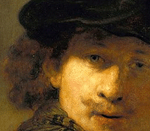
"The Poor Widow"
Marten de Vos (1532 – 4 December 1603) was a Flemish painter. He is known mainly for his history and allegorical paintings and portraits. He was, together with the brothers Ambrosius Francken I and Frans Francken I, one of the leading history painters in the Spanish Netherlands. Maerten de Vos was principally a painter of religious scenes and to a lesser extent of mythological and allegorical themes. Beginning with Mannerism, his style evolved to become clear and descriptive, which perfectly corresponded to the ideas of the Counter-Reformation. Following the outbreaks of destruction of religious images that occurred in Europe in the 16th century de Vos became one of the artists tasked with redecorating the plundered churches with new altarpieces.
Maerten de Vos was not an innovative artist but rather an eclectic figure who borrowed liberally from Italian masters. His work was variously indebted to one or more of the Italian painters Veronese, Tintoretto and Michelangelo, as well as to Flemish painters such as the Master of the Prodigal Son, Pieter Aertsen, and the Flemish painters influenced by Italian art referred to as Romanists such as Lambert Lombard, Frans Floris and Michiel Coxie.His style was very recognizable and his iconography and subject matter were in a distinctly Contra-Reformation vein.